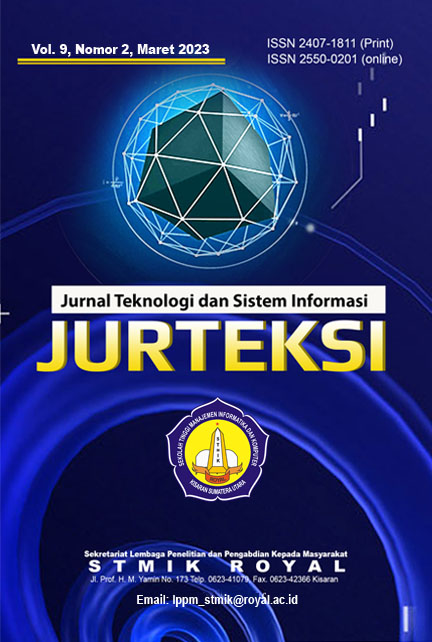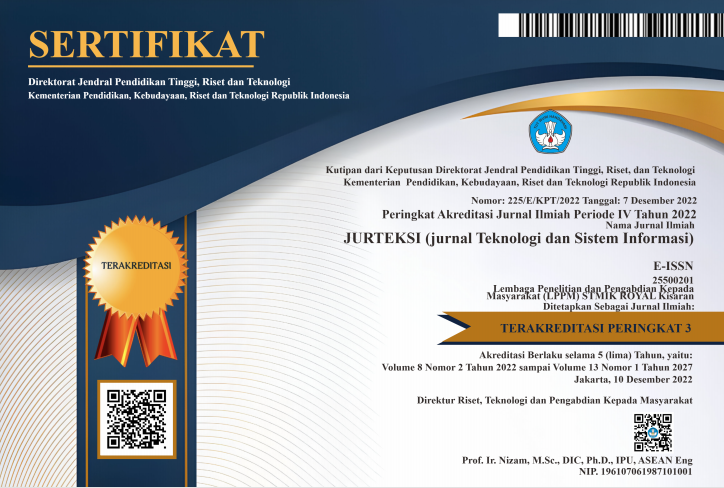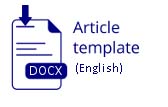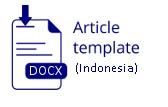ANALYSIS NAIVE BAYES TO SELECTION NEW STUDENTS FOR SUPERIOR CLASS STMIK ROYAL
Abstract
Abstract: Superior students represent active and intelligent students who are able to make a direct contribution to the development of the nation. To produce excellent students, one of the efforts that can be made is to foster these superior students from the start by forming a superior class. In forming a superior class, an effective selection process is needed to select students who are truly superior. This research was conducted at STMIK Royal Kisaran where the object of research was prospective new students for the superior class and the related party was the Academic and Student Administration Bureau (BAAK) because the party was directly involved in selecting prospective new students for the superior class. But the problem is, BAAK does not yet have an election process based on a method and there is no information system for selecting prospective new students for superior classes. The purpose of this study is to make predictions related to the selection of prospective new students for superior classes in the future with the Naïve Bayes Algorithm and implemented in an information system.The results of this research are that the Naïve Bayes algorithm produces an accuracy rate of 60% in the good classification category which is measured by the level of accuracy using the confusion matrix, so that the information system produced in this study also has efficient prediction results and is expected to help BAAK.
Keywords: data mining; naïve bayes; superior student class.
Abstrak: Mahasiswa unggulan merupakan representasi dari mahasiswa aktif dan cerdas yang mampu memberikan kontribusi langsung terhadap perkembangan bangsa. Untuk menghasilkan mahasiswa yang benar unggul salah satu upaya yang dapat dilakukan adalah dengan membina mahasiswa unggulan tersebut sejak awal dengan membentuk kelas unggulan. Dalam membentuk kelas unggulan dibutuhkan proses seleksi yang benar efektif untuk memilih mahasiswa yang benar unggul. Penelitian ini dilakukan di STMIK Royal Kisaran dimana objek penelitian merupakan calon mahasiswa baru untuk kelas unggulan dan pihak yang terkait adalah Biro Administrasi Akademik dan Kemahasiswaan (BAAK) karena pihak tersebut terlibat langsung dalam pemilihan calon mahasiswa baru untuk kelas unggulan. Namun permasalahannya, pihak BAAK belum memiliki sebuah proses pemilihan berdasarkan metode dan belum adanya sistem informasi pemilihan calon mahasiswa baru kelas unggulan. Tujuan dari penelitian ini adalah melakukan prediksi terkait pemilihan calon mahasiswa baru kelas unggulan di masa mendatang dengan Algoritma Naïve Bayes dan diimplementasikan dalam sebuah sistem informasi. Hasil penelitian ini algoritma Naïve Bayes menghasilkan tingkat akurasi sebesar 60% dengan kategori good classification yang diukur tingkat akurasinya dengan menggunakan confusion matrix, sehingga sistem informasi yang dihasilkan dalam penelitian ini juga memiliki hasil prediksi yang efisien dan diharapkan dapat membantu pihak BAAK.
Kata Kunci: data mining; mahasiswa kelas unggulan; naïve bayes.
References
M. A. Putri and A. Supriyanto, “Pembangunan Karakter Mahasiswa Melalui Keikutsertaan Dalam Organisasi Kemahasiswaan,†J. Manaj. UNM, pp. 160–166, 2020, [Online]. Available: http://conference.um.ac.id/index.php/apfip/article/view/405
A. R. Z. Wati and S. Trihantoyo, “Strategi Pengelolaan Kelas Unggulan Dalam Meningkatkan Prestasi Belajar Siswa,†J. Din. Manaj. Pendidik., vol. 5, no. 1, p. 46, 2020, doi: 10.26740/jdmp.v5n1.p46-57.
S. A. Desi Puspita, “IMPLEMENTASI NAIVE BAYES UNTUK SISTEM PREDIKSI MAHASISWA BERPRESTASI,†vol. 8, no. 2, 2022.
S. Eka et al., “Penerapan Model Naive Bayes Untuk Memprediksi Potensi,†vol. 1, no. 1, pp. 82–87, 2021.
H. Hozairi, A. Anwari, and S. Alim, “Implementasi Orange Data Mining Untuk Klasifikasi Kelulusan Mahasiswa Dengan Model K-Nearest Neighbor, Decision Tree Serta Naive Bayes,†Netw. Eng. Res. Oper., vol. 6, no. 2, p. 133, 2021, doi: 10.21107/nero.v6i2.237.
P. Kinerja, K. Pt, S. Guna, and A. Sudrajat, “Penerapan Metode Naïve Bayes Untuk Menentukan Penilaian Kinerja Karyawan PT.Sinergi Guna Solusindo,†vol. 99, no. 99, pp. 1596–1606, 2022.
I. Loelianto, M. S. S. Thayf, and H. Angriani, “Implementasi Teori Naive Bayes Dalam Klasifikasi Calon Mahasiswa Baru Stmik Kharisma Makassar,†SINTECH (Science Inf. Technol. J., vol. 3, no. 2, pp. 110–117, 2020, doi: 10.31598/sintechjournal.v3i2.651
S. Nasional et al., “Implementasi Metode Naïve Bayes Untuk Menentukan Kelas Unggulan Pada Siswa SMP,†pp. 215–220, 2022.
D. P. Utomo, “Analisis Komparasi Metode Klasifikasi Data Mining dan Reduksi Atribut Pada Data Set Penyakit Jantung,†vol. 4, no. April, pp. 437–444, 2020, doi: 10.30865/mib.v4i2.2080.
M. Muhathir and M. H. Santoso, “Analysis Naïve Bayes In Classifying Fruit by Utilizing Hog Feature Extraction,†J. Informatics Telecommun. Eng., vol. 4, no. 1, pp. 151–160, 2020, doi: 10.31289/jite.v4i1.3860.
A. N. Syaiful Zuhri Harahap1, “TEKNIK DATA MINING UNTUK PENENTUAN PAKET HEMAT SEMBAKO DAN KEBUTUHAN HARIAN DENGAN MENGGUNAKAN ALGORITMA FP-GROWTH (STUDI KASUS DI ULFAMART L,†vol. 7, no. 3, pp. 111–119, 2019.
B. P. Pratiwi, A. S. Handayani, and S. Sarjana, “Pengukuran Kinerja Sistem Kualitas Udara Dengan Teknologi Wsn Menggunakan Confusion Matrix,†J. Inform. Upgris, vol. 6, no. 2, pp. 66–75, 2021, doi: 10.26877/jiu.v6i2.6552.
N. Sabila et al., “IMPLEMENTATION OF WEB-BASED NAIVE BAYES ALGORITHM FOR DETERMINING DEPARTMENTS AT SMK 10 MUHAMMADIYAH KISARAN IMPLEMENTASI ALGORITMA NAIVE BAYES UNTUK PENENTUAN JURUSAN BERBASIS WEB DI SMK 10 MUHAMMADIYAH,†vol. 3, no. 6, pp. 1729–1737, 2022.













